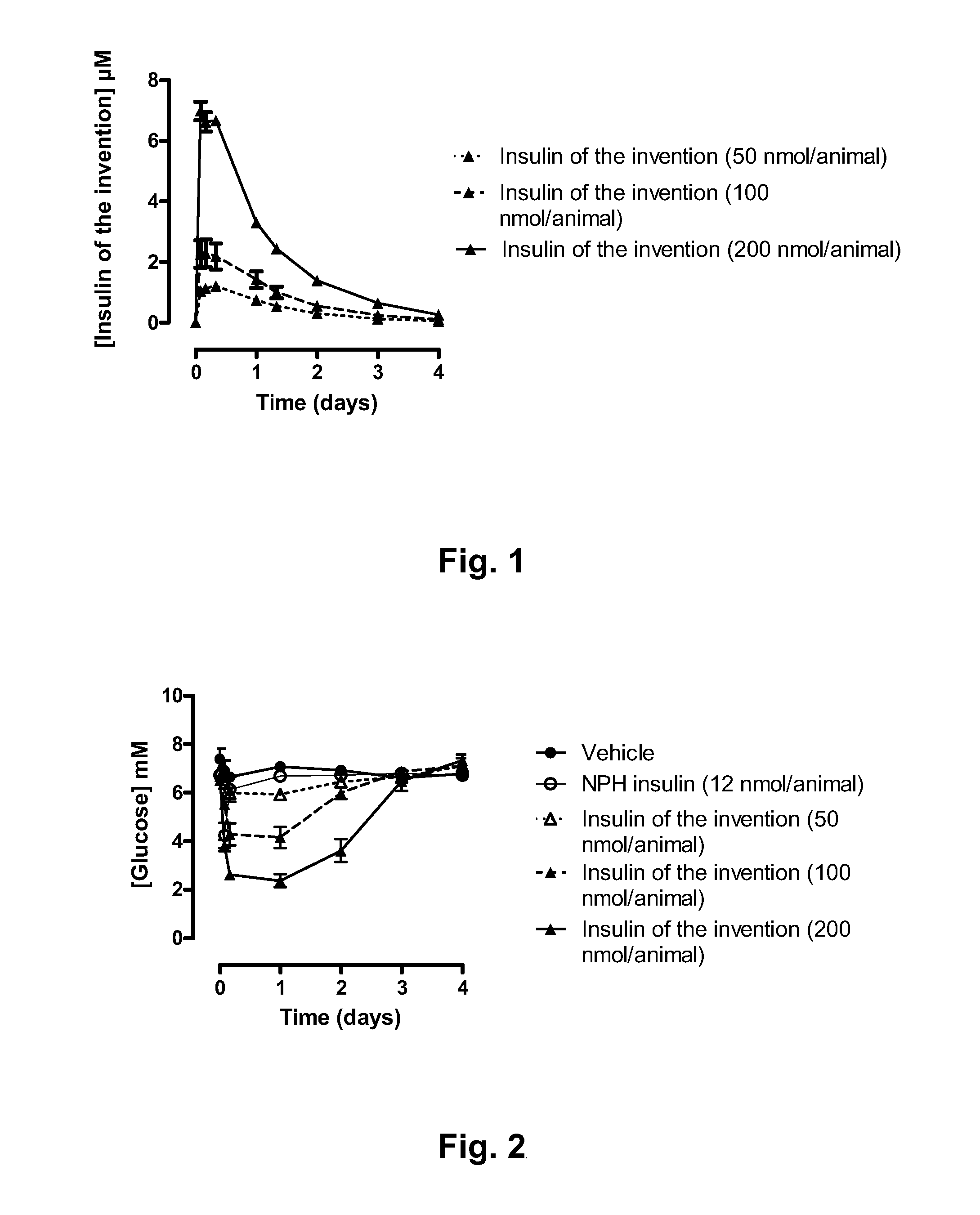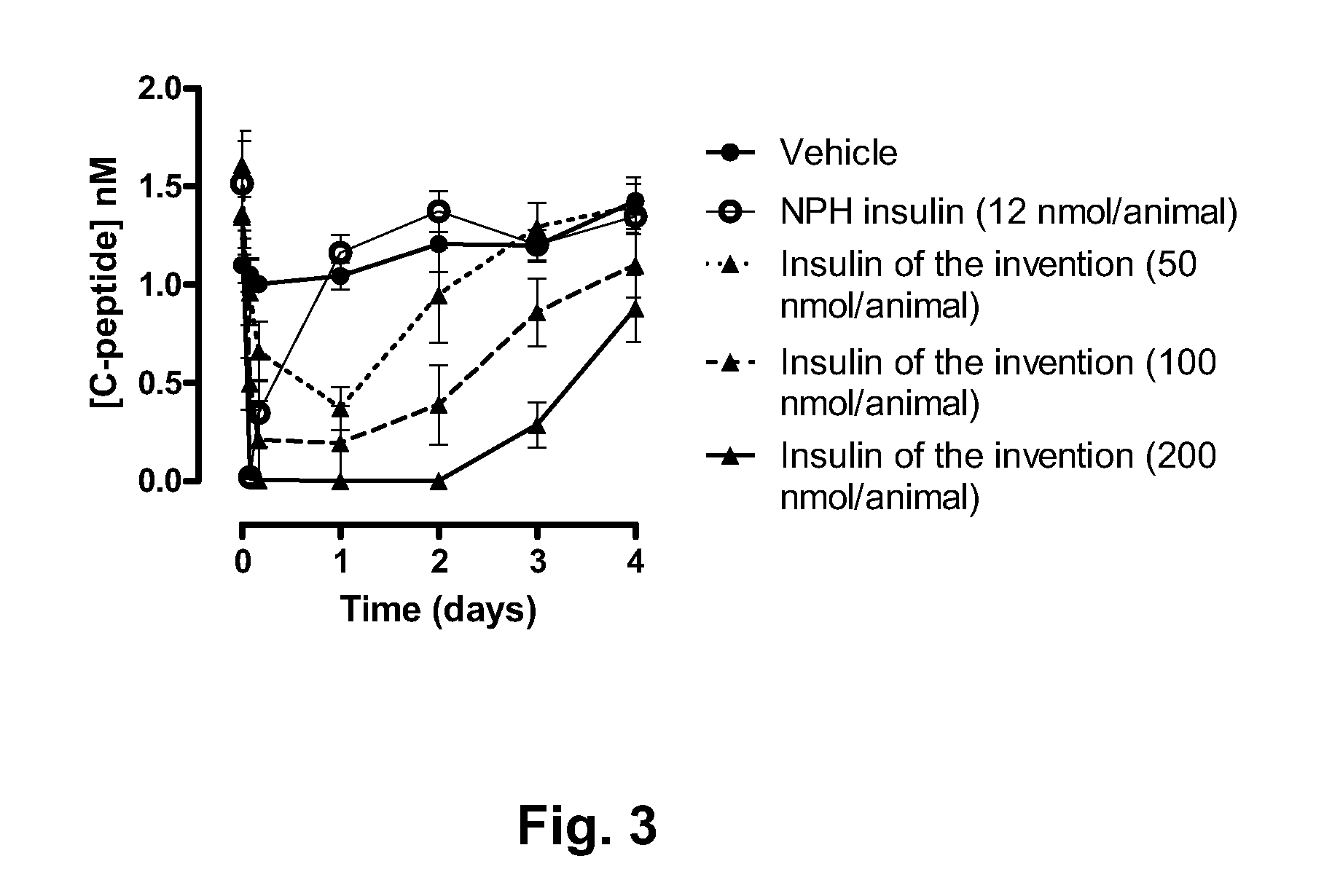Novel use of insulin derivatives
a technology of insulin derivatives and derivatives, which is applied in the field of insulin derivatives, can solve the problems of insufficient control of glucose level for more than one night and day, inability to undertake intensive therapy, and inability to achieve the effect of increasing convenience for patients
- Summary
- Abstract
- Description
- Claims
- Application Information
AI Technical Summary
Benefits of technology
Problems solved by technology
Method used
Image
Examples
example 1
Effect of Subcutaneously Administered Insulin Analogue of the Invention on Blood Glucose, C-Peptide, and HbA1c Versus NPH Insulin and Vehicle in Sprague Dawley Rats
[0076]Rats were allowed free access to food and water prior to the experiment. At time 0 min, 200 μL tongue blood was drawn. The rats (groups of 6 animals) were injected either with vehicle, NPH insulin (12 nmol / animal), and A14E, B16H, B25H, B29K(Nε-eicosanedioyl-γGlu-[2-(2-{2-[2-(2-aminoethoxy)ethoxy]acetylamino}ethoxy)ethoxy]acetyl), desB30 human insulin (Compound 1) (50, 100, and 200 nmol / animal) s.c in the neck skin. At following time points, blood samples were drawn: 2, 4, 6, 8, 24, 32, 48, 72, and 96 hours. Blood samples were analysed for insulin exposure, C-peptide, plasma glucose, and HbA1c (HbA1c only 96 h time point). The results are presented in FIGS. 1-4:
[0077]FIG. 1 shows the plasma concentration levels following dosing of 3 different doses of Compound 1 (50, 100 and 200 nmol / animal) to rats within the time ...
example 2
[0086]Pharmacokinetic profiles after intravenously (i.v.) dosing were made in Beagle dogs (weighing approximately 12 kg) to evaluate the pharmacokinetic properties of insulin degludec (Insulin degludec is a once-daily basal insulin analogue with an ultra-long duration of action described in e.g. WO 2005 / 012347), and to evaluate the pharmacokinetic properties of a compound of formula I, i.e., A14E, B16H, B25H, B29K(Nε-eicosanedioyl-γGlu-[2-(2-{2-[2-(2-aminoethoxy)ethoxy]acetylamino}ethoxy)ethoxy]acetyl), desB30 human insulin (Compound 1). It was also desirable to be able to calculate the bioavailability after extravascular dosing. The animals were dosed i.v., 1.0 or 1.6 nmol / kg of insulin degludec or Compound 1, respectively, blood samples were collected and plasma analysed using sandwich immunoassay.
[0087]Pharmacokinetic profiles after subcutaneous (s.c.) profile were made in Beagle dogs (approximately 12 kg), to evaluate the pharmacokinetic properties after s.c. dosing. 4.1 or 17 n...
example 3
[0090]Pharmacokinetic simulation was performed to show that A14E, B25H, B29K(Nε-octadecandioyl-γGlu-2xOEG), desB30 human insulin (Compound 6) could be injected twice weekly to humans with similar flat steady state plasma concentration profile as insulin degludec injected every day.
[0091]The simulation was performed using the software WinNonlin Professional 5.3 (Pharsight Inc., Mountain View, Calif., USA). A simple one compartment model with first order elimination and absorption rate was used to simulate insulin degludec dosing once daily (every 24 hour) and Compound 6, dosing once daily (every 24 hour) and in addition twice weekly (every 84 h). Average pharmacokinetic parameters from human studies were used for insulin degludec (absorption rate constant=0.031 h−1 and elimination rate constant=0.25 h−1 corresponding to absorption half-life of 22 hours and elimination half-life of 2.8 hours). For Compound 6, average parameters from human studies were used for the elimination rate con...
PUM
| Property | Measurement | Unit |
|---|---|---|
| period of time | aaaaa | aaaaa |
| time | aaaaa | aaaaa |
| time | aaaaa | aaaaa |
Abstract
Description
Claims
Application Information
 Login to View More
Login to View More - R&D
- Intellectual Property
- Life Sciences
- Materials
- Tech Scout
- Unparalleled Data Quality
- Higher Quality Content
- 60% Fewer Hallucinations
Browse by: Latest US Patents, China's latest patents, Technical Efficacy Thesaurus, Application Domain, Technology Topic, Popular Technical Reports.
© 2025 PatSnap. All rights reserved.Legal|Privacy policy|Modern Slavery Act Transparency Statement|Sitemap|About US| Contact US: help@patsnap.com



